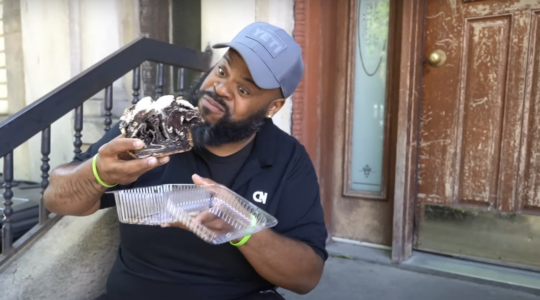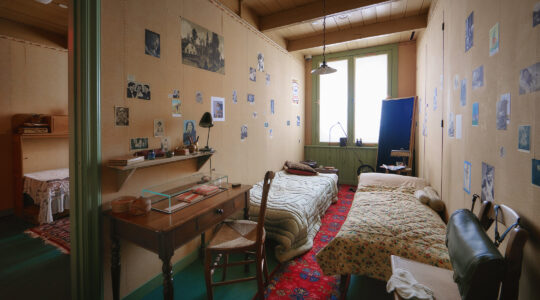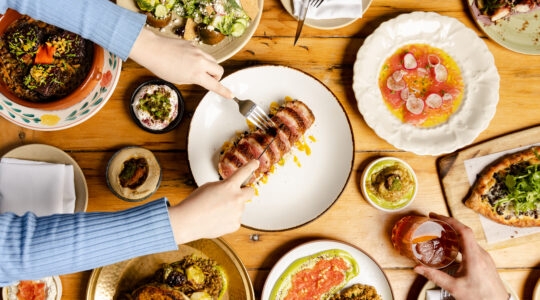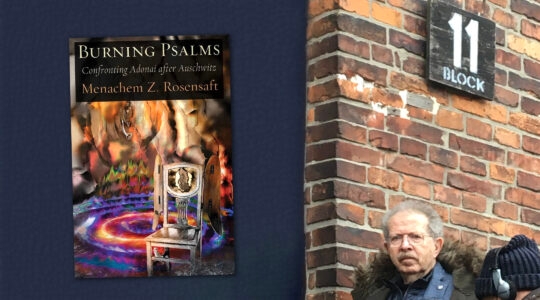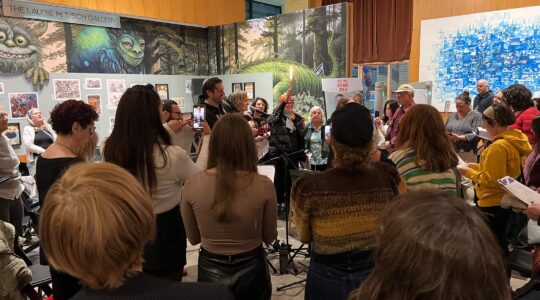As dusk fell on a Saturday night not long ago, 45 Jewish children and their parents gathered together on the deck outside a retreat center dining room in the northern reaches of Connecticut to bid farewell to the Sabbath.
While watching the light of the braided Havdalah candle reflecting in their children’s eyes, many of the parents felt emotion well up. They had never before seen their children with so many others like themselves. For once – but only for a few days, at the retreat – their child wasn’t the only Jew with brown skin.
They came together for the retreat of the Multi-Racial Jewish Family Network, a nascent organization whose members are part of Jewish families where at least one person isn’t white.
“It’s the only time these kids are with so many other nonwhite Jews, and it changes their view of Judaism,” said Jean Weinberg, a founder of the group. Most of the time they’re living among “people who forget that white Ashkenazim aren’t the whole world.”
Weinberg and her husband adopted a daughter, Sarah, whose birth mother is Swedish and birth father is African American.
The retreats began four years ago when Weinberg’s family got together with another to create “a place where our kids can go that is Jewish and they won’t feel alone,” she said.
They are now trying to turn it from an annual retreat into an ongoing network, and just received funding — a $25,000 grant from the Nathan Cummings Foundation — to establish an office and hire part-time staff.
American Jewish families in which an adopted child or a converted parent is black, Asian, Hispanic or biracial constitute a rapidly growing population, say sociologists. “This is the changing face of American Jewry,” said Rabbi Susan Silverman, who with her husband has two biological daughters and recently adopted a son who is black from an orphanage in Ethiopia.
The 1990 National Jewish Population Study – the last completed “census” of American Jewry – found that 6.5 percent of all respondents were nonwhite, said Gary Tobin, president of the Institute for Jewish and Community Research in San Francisco, and himself the adoptive father of a black child, Jonah.
Four percent of the study’s core population — meaning Jews by birth or conversion — were black or Hispanic, he said, which equaled about 220,000 people.
A decade after the study, it’s now possible that through adoption, adult conversion and intermarriage, the percentage of nonwhite Jews in America is as high as 10 percent, Tobin says.
Adoption is responsible for a large part of the surge. In years past most foreign babies adopted by Americans were born in Korea, Vietnam and Latin America. Americans — of all religions and ethnicities — continue to adopt children from those countries, but today, experts say, the former Soviet Union and China are the leading birth countries in international adoptions and are the source of 4,500 and 4,000 children, respectively.
And while domestic adoptions of children from black and Hispanic backgrounds were first seen in significant numbers in the early 1970s, they seem to be increasingly popular among Jewish parents today.
One adoption professional estimated that between 15 percent and 20 percent of the children currently being adopted into Jewish families are Hispanic or nonwhite.
The other doorway into the Jewish community is, of course, adult conversion, and their children, but it’s not known how many people within that category are nonwhite, Tobin said, because that has never been measured.
“The issue of race has barely been on the radar screen of the Jewish research community,” he said.
Negotiating
Two Cultures
The personal experience of Tobin and his wife, Diane, in adopting Jonah led them to develop the Ethnic and Racial Diversity Study of the Jewish Community. It began a year ago and is now concluding the first phase of research on 500 families.
Reflecting the isolation that nonwhite Jews often feel, the respondents have been hungry for ongoing contact “with people like themselves,” said Diane Tobin, who is directing the study. In response, the project has also turned into a network, with periodic meetings and speakers in the San Francisco area.
An ideological debate is taking place between families who have nonwhite, or biracial children, over which element of the children’s heritage to emphasize. Some feel it’s important to focus primarily on the Jewishness. That’s the approach of Rabbi Silverman and her husband, Yossi Abramowitz, whose son Adar joined them last year.
“Some people question whether it’s fair to impose Judaism on this child from another culture,” said Rabbi Silverman, whose family is involved with the Multi-Racial Jewish Family Network.
“People have asked me ‘what if he doesn’t want this one day?’ I can’t predict what my two daughters will want either as adults, but I do know what I can put in their spiritual backpacks,” said the rabbi, who has hosted other multiracial Jewish families for Shabbat dinner at her home in Newton, Mass.
Other parents try to make sure their children are exposed to role models and experiences that relate specifically to their non-Jewish ethnic identity. Sometimes a parent tries both approaches within one family.
Marcy Perlman Tardio is the Ashkenazi mother of two sons whose father is Afro-Peruvian. When her older son, Java, who is 27, was young, Perlman Tardio made it a priority for him to spend time with men of color. When he was in college he became very afrocentric, she said. He no longer identifies as a Jew and today is engaged to marry a non-Jewish woman who is also of mixed race.
With her younger son, who is 7, “I felt like I didn’t want race to be an issue. I thought we could raise him as a young man of color who had a Latin background and is a Jew. Then his dad stopped speaking Spanish to him, and more of the cultural exposure was happening through his Jewish world,” said Perlman Tardio, who lives in the Park Slope section of Brooklyn.
Her younger son, Levi, attends Jewish day school though in his school, unlike many others, there are other some other nonwhite children, reflecting the unusually diverse nature of their community.
Perlman Tardio struggled for months to find a summer camp where Levi would meet other Jews of color. She couldn’t find one and resigned herself to sending him to a non-Jewish camp with a multicultural approach.
“I didn’t want it to be either-or,” she said. “Ideally you don’t separate one part of your life from another. It’s a reflection of the Jewish community and a disappointment to feel that it’s not as diverse as it should be. It took me going to Israel to realize that we as a Jewish people are more diverse. My big question is why are we so separate here.”
Isolation is a big issue for nonwhite Jews and their parents, since there are few communities where there are more than one or two Jewish families with nonwhite members. More diversity is found on the Upper West Side and in Brownstone Brooklyn, the Boston area and parts of northern California.
The racism they feel their children are bound to face is also a major concern for parents of nonwhite Jewish children.
Tse Quan Levy is of Chinese ancestry and grew up in Malaysia. She converted to Judaism shortly before marrying Daniel. Together they have two sons, Benjamin, 7, and Eli, 5.
While they live in a Jewish community as racially diverse as any get, in Brooklyn Heights, Levy said she feels a real difference between the reception her children get when they are shopping with her in Borough Park, Brooklyn, and in Chinatown, in Manhattan.
Even her younger son has picked it up, she said. When they go to Borough Park, people are cold and stare at them, Levy said. But when they go to Chinatown, other people coo over him. As a result, Eli doesn’t like to go to Borough Park, she said.
No one in her husband’s Orthodox family questions the Jewishness of Levy or her children. They totally accepted her as a Jew once she converted with an Orthodox rabbi, said Daniel. But his secular Jewish friends have questioned how Jewish Ben and Eli really are, which has caused strains in their relationships, he said.
Multiracial Jewish families realize that they occasionally have to go further than all-white Jewish families might to ensure that their children are accepted as Jews. The Levy’s mohel insisted that three “kosher” witnesses, men who are observant, be present at the brit milah of each boy in case anyone should question the validity of their status in the future, said Daniel.
Gary Tobin knows that his son Jonah may be treated differently than his older siblings, who were born to the couple. “He will be a minority within a minority wherever he goes, as a black being raised in a white family, as a black within the Jewish community.”
Parents sometimes anticipate more racism than exists, they say, and some think they have to prepare their children to deal with it. When Jana Wolff was preparing to send her son, Ari, who is now 9 and adopted, to a Reform-movement overnight camp last summer for the first time, she role-played with him responses if someone told him he couldn’t be Jewish because he is black.
No one did, though, and he had a great time; he’s going back this summer. But as emotionally and spiritually complex as adoption is for anyone, it is all the more so for those who adopt from different ethnic backgrounds.
“Adopting interracially is like donning a permanent sandwich board that advertises your adoption (and your infertility too),” wrote Wolff in her book “Secret Thoughts of an Adoptive Mother.”
In an interview from her home in Hawaii, Wolff said, “We’ve increased the ways in which Ari stands out. He’s different by being adopted, by being Jewish, by living in Hawaii, by having a Hebrew name. And it’s very hard to think you’ve contributed to making things difficult for your child.”
For those reasons, some consciously decide against adopting cross-racially.
Rabbi Simkha Weintraub and his wife, Simha Rosenberg, had already adopted Adin, who is white, when they investigated adopting a second child. They were offered a nonwhite baby, who they turned down.
“It was a wrenching experience for us,” said Rabbi Weintraub, a Brooklyn resident who works as rabbinic director of the National Center for Jewish Healing in Manhattan. “We didn’t want to put Adin in the position of having to answer questions about his sister or brother every time they went to the playground. We didn’t want to impose a neon sign on them.”
Since then the couple have welcomed Meirav, who is Caucasian and now 5, into their family.
It seems clear that the number of multiracial Jewish families is growing through both adoption and birth to parents who have converted to Judaism. But the welcome they now get is mixed.
The ultimate test of the Jewish community’s embrace of diversity will come, say the parents of nonwhite children, when it is time for them to marry.
The New York Jewish Week brings you the stories behind the headlines, keeping you connected to Jewish life in New York. Help sustain the reporting you trust by donating today.
